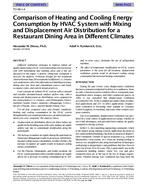
TO-98-01-4 — Comparison of Heating and Cooling Energy Consumption by HVAC System with Mixing and Displacement Air Distribution for a Restaurant Dining Area in Different Climates
- Comments Off on TO-98-01-4 — Comparison of Heating and Cooling Energy Consumption by HVAC System with Mixing and Displacement Air Distribution for a Restaurant Dining Area in Different Climates
- ASHRAE
Click here to purchase
Different ventilation strategies to improve indoor air quality and to reduce HVAC system operating costs in a restaurant with nonsmoking and smoking areas and a bar are discussed in this paper. A generic sitting-type restaurant is used for the analysis. Prototype designs for the restaurant chain with more than 200 restaurants in different U.S. climates were analyzed to collect the information on building envelope, dining area size, heat and contaminant sources and loads, occupancy rates, and current design practices. Four constant air volume HVAC systems with a constant and variable (demand-based) outdoor airflow rate, with a mixing and displacement air distribution, were compared in five representative U.S. climates: cold (Minneapolis, Minn.); maritime (Seattle, Wash.); moderate (Albuquerque, N.Mex.); hot-dry (Phoenix, Ariz.); and hot-humid (Miami, Fla.). For all four compared cases and climatic conditions, heating and cooling consumption by the HVAC system throughout the year-round operation was calculated and operation costs were compared. The analysis shows:
- Displacement air distribution allows for better indoor air quality in the breathing zone at the same outdoor air supply airflow rate due to contaminant stratification along the room height.
- The increase in outdoor air supply during the peak hours in Miami and Albuquerque results in an increase of both heating and cooling energy consumption. In other climates, the increase in outdoor air supply results in reduced cooling energy consumption.
- For the Phoenix, Minneapolis, and Seattle locations, the HVAC system operation with a variable outdoor air supply allows for a decrease in cooling consumption up to 50% and, in some cases, eliminates the use of refrigeration machines.
- The effect of temperature stratification on HVAC system parameters is the same for all locations; displacement ventilation systems result in decreased cooling energy consumption but increased heating consumption.
Citation: Symposium, ASHRAE Transactions, 1998, Vol. 104, Part 2, Toronto, ON
Product Details
- Published:
- 1998
- Number of Pages:
- 12
- File Size:
- 1 file , 310 KB
- Product Code(s):
- D-7688

